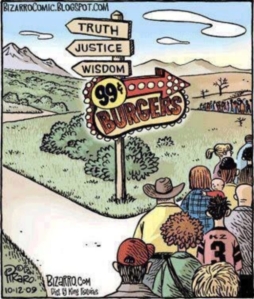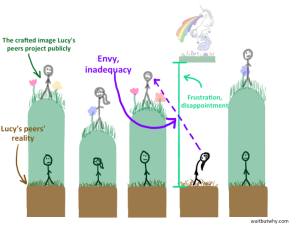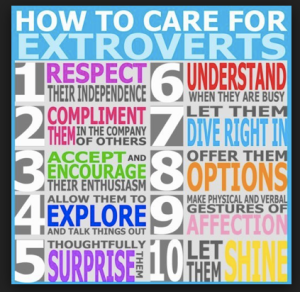Bordas (2007) brought up the point of generosity as a key trait of leadership towards the beginning of Salsa, Soul, and Spirit:
Generosity is the basis for a more compassionate and caring society–the rich soil from which the benevolent society can grow. Generosity is the antidote to the rampant materialism that reinforces individualistic gain over the common welfare (p. 73).
It got me questioning if we, as humans, are hard wired for generosity or if it’s all about survival of the fittest. So, I decided whether to see if any brain studies had been done regarding which parts of the brain were activated when people acted generously.
In the mid 2000s, a Dr. Gafman measured the brain activity of 19 participants who were given a long list of charity organizations and a fund of money. For each charity the subject could donate some portion of their fund, not donate to the charity, or put aside money in a separate reward account that they could take home at the end of the study.
What was found was that when participants decided to give to a charity organization parts of the midbrain lit up, the same part of the brain that controls cravings for sex and food and the same part of the brain that activated when participants decided to give to their reward account. “This new evidence suggests that giving is actually inherently rewarding: The brain churns out a pleasurable response when we engage in it” (Svoboda, 2013).
It is my assumption, yes my assumption, that all of us engaged in this class would characterize ourselves as having a generous spirit, but is having a generous spirit good for leadership, good for organizations and good for our selves?
It has been argued and studied that businesses perform better when their leaders and employees are ‘givers’ not ‘takers’ (Martinuzzi, 2013). How do leaders embody the generous leader? Here are a few clear examples of what generous leaders do, which as can be seen mesh quite well with other transformational leadership qualities we have explored thus far.
- Give people a sense of importance: Make people feel that the work they do is important, which builds trust in the workplace.
- Give feedback, not criticism
- Share their time and expertise
- Recognize the full potential in people
- They lead by example
- They lead with purpose
(Crowley, 2013; Holmes, 2013; Martinuzzi, 2013)
So, yes it seems that generosity in leadership is good for organizations, but it is good for our careers?
Can you guess what the answer is? Yes, well in some cases.
In his 2013 book, Give and Take, Wharton professor Adam Grant lays out the three types of people in organizations. (Adam Grant also happens to be the youngest tenured and highest rated professor at Wharton’s MBA program, so apparently he knows what he’s talking about. He’s successful and respected). The three types are:
Takers: Takers like to get more than they give. They put their own interests ahead of others and seek to come out ahead in every exchange.
Matchers: The majority of us are matchers, and we generally give to others in expectation our favors will be returned.
Givers: Givers want to help others independent of an easily foreseeable payback. They’re generous with time and expertise, and go out of their way to help others succeed.
What Adam Grant found in doing research for his book was that givers were most likely not to succeed (success being measured as work performance, completion of tasks and job position), because going out of their way to help people prevents them from getting their own work done. What was interesting was that he found that givers were also the most likely to land at the very top. It turns out givers aren’t any less ambitious than takers, they just have a different way of going about it. And when givers are at the top Grant found, there is a ripple effect.
Givers, takers, and matchers all can— and do— achieve success. But there’s something distinctive that happens when givers succeed: it spreads and cascades. When takers win, there’s usually someone else who loses. Research shows that people tend to envy successful takers and look for ways to knock them down a notch. In contrast, when [givers] win, people are rooting for them and supporting them, rather than gunning for them. Givers succeed in a way that creates a ripple effect, enhancing the success of people around them. You’ll see that the difference lies in how giver success creates value, instead of just claiming it.
(Popova, 2013)
So how can you make sure you are a ‘successful’ giver and not one whose work suffers? I would argue this would entail being generous to yourself, remaining self-confident and keeping a good work/life balance. But what do you think? Have you witnessed leaders in your organizations that are over-givers? Have you witnessed generous leadership at its best?
And an Interesting note about Darwin’s 828 pages of Origins of Species is that he mentions “survival of the fittest” twice and “love” 95 times (http://www.thedarwinproject.com/revolution/revolution.html). Why is it that as a society we have latched onto the notion of survival of the fittest? And by broadening our individualistic definition of survival would generosity fit within this notion?
So, channel your inner Meerkat (argued as the most altruistic animal) and let the ripple effect begin.
Retrieved from: http://londonleprechaun.com/2013/08/22/home-sweet-home/
References
Bordas, J. (2007). Salsa, soul, and spirit: Leadership for a multicultural age. San Francisco: Berrett-Koehler Publishers, Inc.
Crowley, M. (2013, May 6). Extreme giver Adam Grant lends us his advice on becoming a more generous leader [Web log post]. Retrieved from: http://www.fastcompany.com/3009323/leadership-now/extreme-giver-adam-grant-lends-us-his-advice-on-becoming-a-more-generous-lead
Holmes, M. (2013, Aug 8). Why generosity is the new leadership [Web log post]. Retrieved from: http://tithehacker.com/generosity-new-leadership/
Martinuzzi, B (2013). Degrees of giving: Leading with generosity [Web log post]. Retrieved from: http://www.mindtools.com/pages/article/newLDR_55.htm
Popova, M (2013). Givers, matchers, takers: The surprising science of success [Web log post]. Retrieved from: http://www.brainpickings.org/index.php/2013/04/10/adam-grant-give-and-take/
Svoboda, E. (2013). Scientists are finding that we are hard-wired for giving. Retrieved from: http://generosityresearch.nd.edu/news/42488-hard-wired-for-giving/























You must be logged in to post a comment.